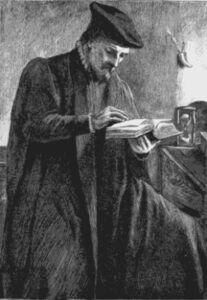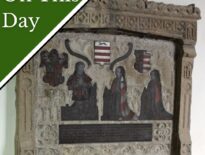 On this day in Tudor history, 19th August 1531, in the reign of King Henry VIII, Reformer Thomas Bilney was burnt at the stake at Lollards' Pit, just outside Bishopsgate, Norwich.
On this day in Tudor history, 19th August 1531, in the reign of King Henry VIII, Reformer Thomas Bilney was burnt at the stake at Lollards' Pit, just outside Bishopsgate, Norwich.
Although Bilney was burnt as a heretic, he actually denied his reformist views and affirmed his Catholic faith at his execution.
Here are some facts about Thomas Bilney:
- Very little is known about Thomas Bilney's background. He came from Norfolk and was born in around 1495.
- He studied law at Trinity Hall, Cambridge.
- Bilney was ordained as a priest in 1519 at Ely in Cambridgeshire.
- In 1524, Bilney was elected to a fellowship at Trinity Hall and went on to serve as a proctor there.
- Bilney was struck by a verse in St Paul's First Epistle to Timothy in Erasmus's New Testament, which he began reading in 1516, and became a religious reformer. Hugh Latimer, who later became Bishop of Worcester and who was also martyred, was converted by Bilney at Cambridge.
- Bilney became licensed to preach in the diocese of Ely in 1525. His biographer P.R.N. Carter explains that Bilney's evangelical preaching "attracted the attention of the ecclesiastical authorities, but Cardinal Wolsey treated him leniently, simply demanding that he swear an oath not to preach Lutheran heresy".
- In 1527, Bilney and Thomas Arthur got into trouble after attacking pilgrimages, prayers to the saints, idolatry, and even advising Henry VIII to smash these false idols. The two men were arrested in November 1527 and had to appear before Wolsey and other clergymen. Carter explains that Wolsey was only interested in acting against Lutherans, and Bilney wasn't a follower of Luther, so the cardinal turned the case over to Cuthbert Tunstall, Bishop of London, for trial.
- During his trial in December 1527, Bilney claimed that he could not remember what he'd preached about. He then abjured, although he never confessed to preaching heresy, and was sentenced to penance and imprisonment.
- Bilney was released from prison in 1529. He heavily regretted abjuring, an act which impacted his health, and so in early 1531 he set about preaching his evangelical views again in Norwich and giving out the works of heretic and Bible translator William Tyndale.
- In March 1531, Bilney was arrested after arriving in London. He was sent back to Norwich and imprisoned. There, despite appealing to Henry VIII, he was tried by Thomas Pelles, Chancellor of Norwich Diocese, and condemned for heresy. He spent his last months imprisoned in the Norwich Guildhall.
- On 19th August 1531, Thomas Bilney was escorted to the Lollards' Pit, just outside Bishopsgate, Norwich, to be burnt for heresy. At his execution, Bilney denied his reformist views and affirmed his Catholic faith.
- Bilney is remembered along with Protestant martyrs Hugh Latimer and Robert Barnes in a tablet at St Edward's Church, Cambridge, where he used to preach.
Also on this day in Tudor history...
Image: An illustration of Thomas Bilney from John Foxe's Book of Martyrs.
Notes and Sources
- Carter, P. (2004, September 23). Bilney, Thomas (c. 1495–1531), evangelical reformer and martyr. Oxford Dictionary of National Biography. Retrieved 17 Aug. 2023, from https://www.oxforddnb.com/view/10.1093/ref:odnb/9780198614128.001.0001/odnb-9780198614128-e-2400.



Leave a Reply